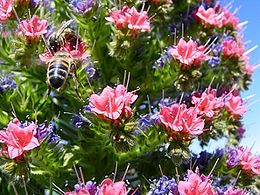Echium candicans- Pride of Madeira
This plant is one more denizen of the cloud forest that has successfully adapted to the So Cal coast. The ones in the picture are a rather sedate size, but given their head echium candicans can and will grow to 6 feet. As the name suggests they hale from the island of Madeira off the coast of Africa
Hummingbirds particularly would love this combination as aloe arborescens is one of their favorite plants.
Pride of Madeira is an almost perfect 10-- drought resistant, home for butterflies, bees love it (and the honey is reputed to be very good). It is a bird refuge. The only thing it isn't, since it isn't a succulent--- is fire retardant. However if combined with aloes as above, it becomes lots less flammable.
Echium candicans can be grown from softwood cuttings, or seeds or a 5 gal. plant from the nursery. They are gangly babies, showing little promise of their swan-like conversion into a mass of spectacular blue steeples.
Echium candicans has a first cousin called Tower of Jewels Echium wildpretii a native of Teneriffe very similar to candicans but bigger and redder.
Echium wildpretti- Tower of Jewels
It is classified as a biennial, like parsley, but either this is not true in So Cal, or it self- sows so readily you never notice its biennial nature? (Try saying self-sows so readily a few times...). Anyhow--the bees think it is simply superior:
This plant is one more denizen of the cloud forest that has successfully adapted to the So Cal coast. The ones in the picture are a rather sedate size, but given their head echium candicans can and will grow to 6 feet. As the name suggests they hale from the island of Madeira off the coast of Africa
Their native habitat is windswept, fog wrapped, dry cliffs. This means--- Pride of Madeira is an unsurpassed plant for us to cover steep, difficult slopes with an exuberance of blue steeples in spring and early summer. Once established ( some water the first year) all they'll need is the pruning shears there after.
Bees, butterflies and birds love them.
Echium candicans combined with aloesHummingbirds particularly would love this combination as aloe arborescens is one of their favorite plants.
Pride of Madeira is an almost perfect 10-- drought resistant, home for butterflies, bees love it (and the honey is reputed to be very good). It is a bird refuge. The only thing it isn't, since it isn't a succulent--- is fire retardant. However if combined with aloes as above, it becomes lots less flammable.
Echium candicans has a first cousin called Tower of Jewels Echium wildpretii a native of Teneriffe very similar to candicans but bigger and redder.
Echium wildpretti- Tower of Jewels
It is classified as a biennial, like parsley, but either this is not true in So Cal, or it self- sows so readily you never notice its biennial nature? (Try saying self-sows so readily a few times...). Anyhow--the bees think it is simply superior:
Tower of Jewels close-up with bee (W)
(The Canary Islands and Madeira are very close neighbors off the African coast. Madeira lies slightly to the west of the Canaries at 32.6511° N, 16.9097° W.)
These tough beauties were sent to Kew Gardens in 1777 and were collected by one of the more unsung heroes of the plant world, Francis Masson.
Masson was a Scot, as were many of the great English gardeners. He was the first of the plant hunters from Kew, hired by Joseph Banks* to actually do the heavy lifting of collecting, nurturing and transporting the new species found on Captain Cook's second circumnavigation of the globe aboard the Resolution.
As a gardener/botanist Masson slept and ate with the crew since he did not rank as a "gentleman" in the English caste system. That means a hammock in a 4 foot space.
Masson was dropped off in S. Africa where he spent 2 years collecting,( while Cook proceeded to his death in Hawaii.) Masson collected over 1700 new species for Kew, 500 in S. Africa alone.
Protea- Photo © by Martin Heigen
In 1776 Masson went to Madeira , the Canaries and the Azores collecting the echiums, sending them back to Kew. His Account of the island of St Miguel” was published in 1778 in the “Philosophical Transactions of the Royal Society of London.
A potted palm ( Encephalartos altensteinii) Eastern Cape Giant Cyclad he collected and cared for is still alive at Kew in the Palm House-- the oldest potted plant in the world. It can be seen in the background this painting of Masson at Kew.
Masson was recognized by his contemporaries as the prodigious botanist he was and was made a Fellow of the Linnean Society - a most unusual honor for a "gardener".
" Banks once more persuaded" Masson to go collecting--this time in Canada. Masson spent the next seven years collecting plants in the Great Lakes area of Canada. He died in Montreal.
The genus Massonia is named after Masson. A most unassuming genus.
Massonia echinata (like a hedgehog)
Every time you see an agapantha displaying its blue fireworks, or a Bird of Paradise flaunting itself, a gazania, a Tower of Jewels, a Pride of Madeira--bless Francis Masson.
Note: see the Kew website and one called Unknown Scotland. (Masson was born in Aberdeen and the Scots are rightly proud of him).
*More about Banks in a later blog. He's certainly a hero, but hardly an unknown.























